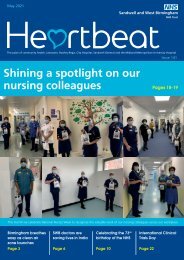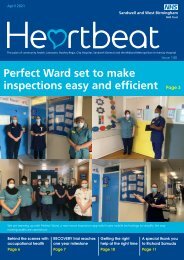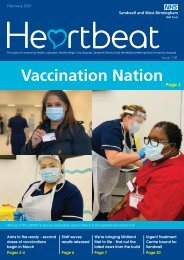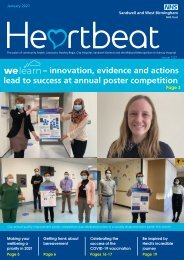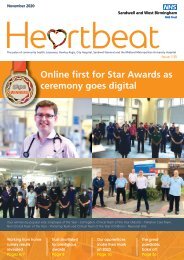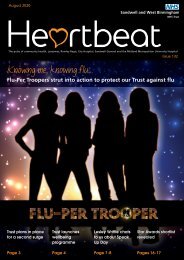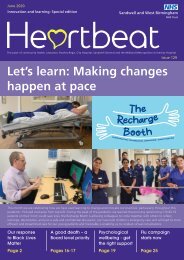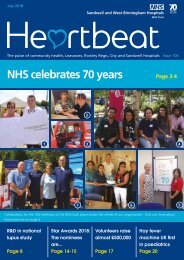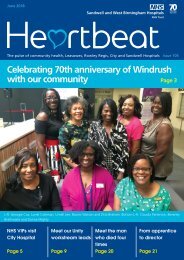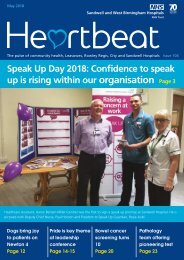Heartbeat July 2020
Create successful ePaper yourself
Turn your PDF publications into a flip-book with our unique Google optimized e-Paper software.
The Krypton Factor – a 40 year<br />
success story<br />
IMAGING<br />
Nuclear medicine, otherwise known<br />
by the friendlier moniker 'medical<br />
physics' at our Trust has recently<br />
celebrated its 40 year anniversary<br />
leading the National Krypton<br />
Generator Service.<br />
What was once a local research project<br />
by Dr K Chackett at our Trust back in the<br />
late 1970s led to a collaboration project<br />
with Birmingham University supplying<br />
the country krypton gas generators,<br />
generators for lung ventilation imaging;<br />
a vital part of the V/Q study for<br />
pulmonary embolus (PE) diagnosis.<br />
Sharing his thoughts Head of Nuclear<br />
Medicine Dr Bill Thomson, said: “My<br />
predecessor, Dr K Chackett, founded<br />
the service and with his knowledge of<br />
the Cyclotron Unit in the Department<br />
of Physics at Birmingham University this<br />
quickly led to a collaboration to produce<br />
the radioactive Rubidium81, which could<br />
be sent to hospitals in the area to be<br />
used in their studies. The Rubidium is<br />
trapped in a small column within a lead<br />
shield and sent to hospitals to be used<br />
the same day.<br />
“The radioactive decay of the<br />
Rubidiumb81 produces a constant<br />
supply of Krypton gas which only has<br />
a 13 second half-life. An airflow pump<br />
sweeps the gas out when needed, is<br />
breathed in by the patient and a gamma<br />
camera gives an immediate picture of<br />
the lungs gas flow. Along with that, a<br />
standard Tc99m radiopharmaceutical<br />
is injected and can image the lung<br />
blood flow. Any lung segments without<br />
perfusion (on the Tc99m images) but<br />
which do have ventilation (on the<br />
Krypton image) can indicate PE.<br />
“At first, our service operated three days<br />
a week, but it soon rapidly expanded as<br />
the demand for imaging for PE grew.<br />
Using our generators, about 15- 20<br />
patients could be scheduled for imaging<br />
in a day, not feasible with the other<br />
agents.<br />
“There were some very nervous times<br />
though. By the late 1990s we were<br />
managing to supply as far as Exeter and<br />
Liverpool, the only other supplier in the<br />
UK was the MRC research cyclotron at<br />
the Hammersmith Hospital, supplying<br />
generators mainly to the London area.”<br />
The generators once faced a potentially<br />
devastating blow that was luckily<br />
From left – Matt Elms, Bill Thomson, Jilly Croasdale, Emma Harrop, Alanah Hefferman (Mark Tudor is<br />
absent, shielding).<br />
avoided. Bill explained: “In 2000, the<br />
university announced they were closing down<br />
their cyclotron. Devastating news! I had to<br />
develop a business plan for a laboratory to be<br />
fitted out on our City site, and arrange for the<br />
Rubidium81 solution to be supplied from the<br />
MRC cyclotron unit in Hammersmith. This was<br />
a complete change in operation, and we had<br />
to rely on our transport service to pick up two<br />
daily batches of radioactive Rubidium81 from<br />
Hammersmith for us to continue operating.<br />
“A further blow came in 2004 when suddenly<br />
Hammersmith Hospital shut down their<br />
service and we quickly had to come up with a<br />
new plan. Luckily, the physics department at<br />
the university had just acquired a second-hand<br />
cyclotron for research work. This cyclotron<br />
was the same model as the MRC system, but<br />
much newer! Serendipity again played a huge<br />
part in keeping the service alive.<br />
“It was also clear that with the expansion<br />
in production we now needed to have the<br />
krypton laboratory beside the cyclotron unit<br />
to cut out the road transfer of very ‘hot’<br />
Rubidiumb81 stock solution. Taking on all<br />
of the Hammersmith production doubled<br />
our production overnight! We also had to<br />
establish new transport routes for the delivery<br />
Official opening of the krypton lab on City site<br />
by Dr Chackett (8th from Left) in 2001 (and Bill<br />
Thomson second left)<br />
of the generators to the whole London area<br />
as well as our local hospitals.<br />
“Finally in 2005, we moved production<br />
back to the university, we finished<br />
production at the City site lab on Friday<br />
morning, while the MRC did their last<br />
production run at the Hammersmith<br />
Hospital. We had to leave time for our<br />
rig activity to decay, so on Saturday and<br />
Sunday, we dismantled and rebuilt the rig at<br />
the university lab (there were LOTS of heavy<br />
lead ‘bricks’ involved! Think LEGO, but with<br />
10kg bricks, all to fit back together in their<br />
place). After testing the rig on Sunday, the<br />
university produced their first run for real,<br />
and we started sending out generators<br />
with no interruption in supply to ours or<br />
the London customers! I still find that<br />
remarkable, and a testimony to the staff<br />
who made the whole new service work<br />
seamlessly.<br />
“In recent years, Computerised Tomography<br />
(CT) scanners have been developed to<br />
provide a diagnosis for pulmonary embolus.<br />
With this ability to run 24/7, this seemed<br />
like the latest death knell for our service.<br />
However, it soon became clear that certain<br />
patients could not have these scans, and<br />
also our lung study gave much lower breast<br />
dose – important in young women, and PE<br />
has a higher incidence during pregnancy.<br />
“I’m sure there will likely be other hurdles<br />
in future. But for now, we are still operating<br />
the only national Krypton81m generator<br />
facility in the UK, providing generators<br />
five days a week to nuclear medicine<br />
departments across England and Wales.<br />
With about 95,000 generators supplied in<br />
the 40 years, and probably more than half a<br />
million patients having their V/Q scan using<br />
our Kr81m, it’s been quite a success from<br />
our simple beginnings 40 years ago.”<br />
22




